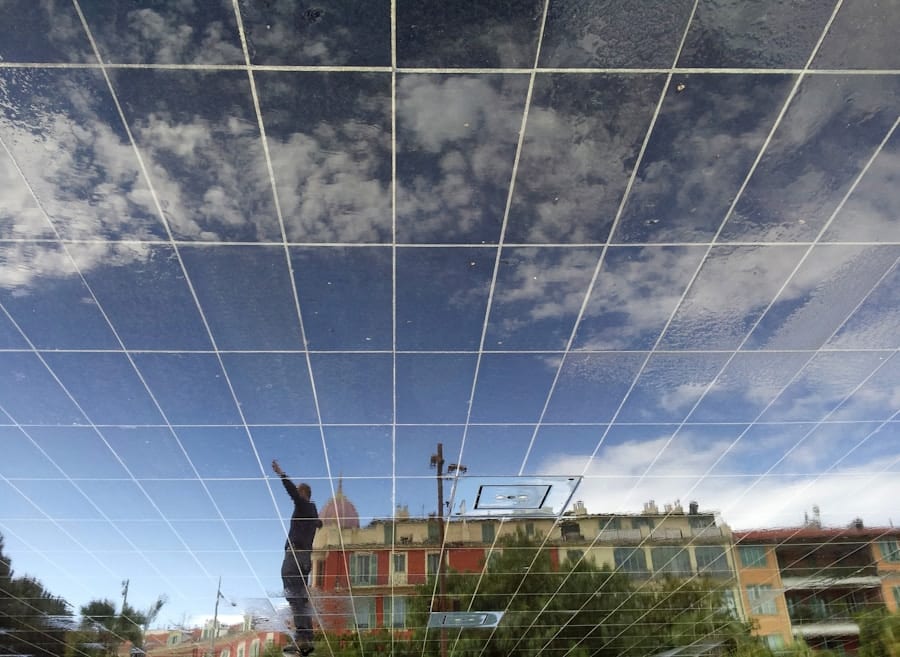Solar paint represents a groundbreaking innovation in the realm of renewable energy, merging the principles of photovoltaic technology with the versatility of traditional paint. This novel concept allows surfaces to harness solar energy, converting sunlight into electricity through a process that is both efficient and aesthetically pleasing. The idea of painting a surface with a material that can generate power opens up a myriad of possibilities for energy generation, particularly in urban environments where space for traditional solar panels is often limited.
As the world grapples with the pressing need for sustainable energy solutions, solar paint emerges as a promising alternative that could revolutionize how we think about energy production. The development of solar paint is rooted in the quest for more accessible and adaptable forms of renewable energy. Traditional solar panels, while effective, require significant space and can be cumbersome to install.
In contrast, solar paint can be applied to a variety of surfaces, including walls, roofs, and even vehicles, making it an attractive option for homeowners and businesses alike. This technology not only aims to enhance energy efficiency but also seeks to integrate seamlessly into our daily lives, transforming ordinary surfaces into power-generating assets. As research progresses, the potential applications and benefits of solar paint continue to expand, positioning it as a key player in the future of sustainable energy.
Key Takeaways
- Solar paint is a revolutionary technology that harnesses solar energy through a paint-like substance applied to various surfaces.
- Solar paint works by using photovoltaic technology to convert sunlight into electricity, making it a versatile and cost-effective solution for renewable energy generation.
- The applications of solar paint are diverse, including use on buildings, vehicles, and even clothing, offering a wide range of possibilities for sustainable energy production.
- Using solar paint offers numerous benefits, such as reduced carbon emissions, lower energy costs, and increased energy independence for individuals and communities.
- Despite its potential, solar paint also faces challenges and limitations, such as efficiency issues and the need for further research and development to optimize its performance.
How Solar Paint Works
Light-Absorbing Nanomaterials
At the core of this technology are nanomaterials, such as perovskite or organic photovoltaics, which are known for their exceptional light-absorbing properties. When sunlight strikes the painted surface, these materials generate excitons—electron-hole pairs that can be separated and directed to create an electric current.
Easy Application and Integration
The application process for solar paint is relatively straightforward. It can be sprayed or rolled onto surfaces much like conventional paint, allowing for easy integration into existing structures. Once applied, the paint forms a thin layer that retains its aesthetic qualities while functioning as a power generator.
Improving Efficiency and Competitiveness
The efficiency of solar paint varies based on factors such as the type of materials used and environmental conditions, but ongoing advancements in nanotechnology are continually improving its performance. Researchers are exploring ways to enhance the light absorption capabilities and overall efficiency of these paints, aiming to make them competitive with traditional solar panels.
Applications of Solar Paint

The versatility of solar paint opens up a wide array of applications across various sectors. One of the most promising uses is in residential settings, where homeowners can apply solar paint to their roofs or exterior walls. This not only provides an aesthetically pleasing solution for energy generation but also allows for greater flexibility in design compared to bulky solar panels.
Additionally, urban environments can benefit significantly from this technology; buildings can be transformed into energy-producing structures without compromising architectural integrity. Beyond residential use, solar paint has potential applications in commercial buildings and public infrastructure. For instance, large-scale projects such as parking garages or bus shelters could utilize solar paint to generate electricity for lighting or charging stations for electric vehicles. Furthermore, vehicles themselves could be coated with solar paint, allowing them to harness energy while parked or even while in motion under certain conditions.
This could lead to significant reductions in reliance on fossil fuels and contribute to a more sustainable transportation ecosystem.
Benefits of Using Solar Paint
The advantages of solar paint extend beyond mere aesthetics and convenience; they encompass economic, environmental, and social dimensions as well. Economically, the ability to generate electricity from surfaces that would otherwise remain passive can lead to substantial savings on energy bills for homeowners and businesses alike. As energy prices continue to rise, the prospect of self-generating power becomes increasingly appealing.
Moreover, the installation costs associated with solar paint are generally lower than those for traditional solar panels, making it a more accessible option for many. From an environmental perspective, solar paint contributes to reducing carbon footprints by promoting the use of renewable energy sources. By integrating energy generation into everyday surfaces, it encourages a shift away from fossil fuels and helps mitigate climate change impacts.
Additionally, the lightweight nature of solar paint means that it can be applied without the need for extensive structural modifications, reducing waste and resource consumption during installation. Socially, the adoption of solar paint can foster greater awareness and acceptance of renewable energy technologies among the general public, paving the way for broader adoption of sustainable practices.
Challenges and Limitations of Solar Paint
Despite its promising potential, solar paint faces several challenges that must be addressed before it can achieve widespread adoption. One significant limitation is its current efficiency compared to traditional solar panels. While advancements in nanotechnology are improving performance metrics, many formulations of solar paint still lag behind conventional photovoltaic systems in terms of energy conversion rates.
This discrepancy raises questions about the viability of solar paint as a primary energy source in regions with limited sunlight or during overcast conditions. Durability is another concern associated with solar paint. Traditional solar panels are designed to withstand harsh weather conditions and have long lifespans; however, the longevity and resilience of painted surfaces remain under scrutiny.
Factors such as UV degradation, moisture exposure, and physical wear could impact the effectiveness of solar paint over time. Researchers are actively investigating ways to enhance the durability of these materials through protective coatings or improved formulations that resist environmental stressors.
Current Research and Development in Solar Paint Technology

Advancements in Materials
Universities and research institutions around the world are exploring innovative materials that could improve light absorption and conversion efficiency. For instance, studies are being conducted on hybrid materials that combine organic photovoltaics with inorganic compounds to create more efficient light-harvesting systems.
Optimizing Application Techniques
Researchers are investigating various application techniques that could optimize the performance of solar paint. Techniques such as spray-coating or screen-printing are being refined to ensure uniform application and maximize surface area exposure to sunlight. Additionally, advancements in nanotechnology are paving the way for new formulations that could lead to higher efficiency rates while maintaining cost-effectiveness.
Collaboration for Practical Solutions
Collaborative efforts between academia and industry are crucial in driving these developments forward, ensuring that practical solutions emerge from theoretical research.
Future Potential of Solar Paint
Looking ahead, the future potential of solar paint appears bright as technological advancements continue to unfold. As efficiency rates improve and durability concerns are addressed, we may witness a paradigm shift in how we approach energy generation in urban environments. The integration of solar paint into building codes and regulations could become commonplace, encouraging architects and builders to incorporate energy-generating surfaces into their designs from the outset.
Furthermore, as public awareness of climate change grows, there is likely to be increased demand for sustainable building materials and practices. Solar paint could play a pivotal role in this movement by providing an accessible means for individuals and businesses to contribute to renewable energy efforts without significant upfront investments or lifestyle changes. The potential for widespread adoption could lead to a decentralized energy model where communities become more self-sufficient in their energy needs.
The Impact of Solar Paint on Renewable Energy
Solar paint stands at the intersection of innovation and sustainability, offering a unique solution to some of the pressing challenges faced by traditional renewable energy technologies. Its ability to transform ordinary surfaces into power-generating assets has far-reaching implications for urban planning, architecture, and individual energy consumption patterns. As research continues to advance this technology, it holds the promise of making renewable energy more accessible and integrated into our daily lives.
The impact of solar paint on renewable energy could be profound, fostering a culture of sustainability that encourages individuals and communities to take charge of their energy production. By harnessing sunlight through innovative means such as solar paint, we can move closer to achieving a cleaner, greener future where energy generation is seamlessly woven into the fabric of our built environment. As we navigate the complexities of climate change and resource depletion, technologies like solar paint will be essential in shaping a sustainable world for generations to come.
If you are interested in innovative technology like solar paint, you may also want to check out this article on the best software for project management.
Both technologies showcase the power of innovation in improving efficiency and sustainability.
FAQs
What is solar paint?
Solar paint is a type of paint that contains photovoltaic materials, allowing it to convert sunlight into electricity. It can be applied to various surfaces, turning them into power generators.
How does solar paint work?
Solar paint works by using photovoltaic materials to capture sunlight and convert it into electricity. When sunlight hits the painted surface, the photovoltaic materials generate a flow of electrons, creating an electric current.
What are the potential applications of solar paint?
Solar paint has the potential to be used on a wide range of surfaces, including buildings, vehicles, and even clothing. It could be used to power small electronic devices, provide energy for lighting, or contribute to larger-scale energy generation.
Is solar paint commercially available?
While there has been significant research and development in the field of solar paint, it is not yet widely available for commercial use. However, there are ongoing efforts to bring this technology to market.
What are the benefits of using solar paint?
Using solar paint can provide a renewable and sustainable source of energy, reduce reliance on traditional power sources, and potentially lower energy costs. It also has the advantage of being able to be applied to a variety of surfaces, making it a versatile energy solution.

